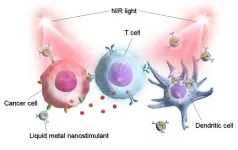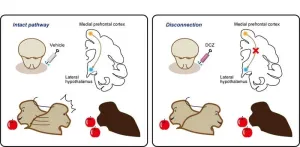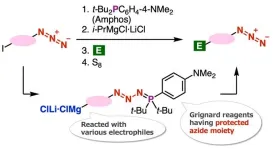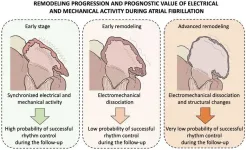In a new cutting-edge study, Associate Professor Eijiro Miyako and his colleagues from Japan Advanced Institute of Science and Technology (JAIST) synthesized multifunctional Ga-based nanoparticles that combine cancer phototherapy with immunotherapy. The synthesized novel LM nanoparticle (PEG-IMIQ-LM) contains a eutectic gallium-indium (EGaIn) LM alloy and an immunological modulator imiquimod (IMIQ), both embedded inside a biocompatible surfactant DSPE-PEG2000-NH2. The detailed findings of their study were published in Advanced Functional Materials.
“We believe that the convergence of nano-immuno engineering and LM technology could provide a promising modality to trigger ideal immune responses for advancing cancer immunotherapy. In this study, we report light-activatable multifunctional LM nanoparticles with immunostimulants to combine photothermal therapy with immunotherapy,” says Dr. Miyako, while discussing the team’s motivation to conduct this study.
First, the research team prepared water-dispersible LM nanoparticles through a simple one-step sonication process using DSPE-PEG2000-NH2 to introduce IMIQ. This is considered a huge breakthrough, as EGaIn LM is inherently a water-immiscible material. Further investigations confirmed that LM disintegrates to ensure IMIQ delivery to the target. Moreover, the prepared nanoparticle displayed a linear increase in absorbance in the near-infrared (NIR) region at 808 nm, confirming its optically activatable nature.
When the aqueous solution of the LM nanoparticle was irradiated by the NIR laser (808 nm), the team observed a notable increase in the temperature of the solution, which was proportional to the increase in the nanoparticle concentration. These findings confirmed that PEG-IMIQ-LM nanoparticle was a robust and stable photothermal drug carrier, suitable for immunotherapy.
Further experiments revealed that LM nanoparticles were extremely safe and did not cause cytotoxicity in human fibroblast (MRC5) and mouse colon cancer (Colon26) cells. To assess the degree of internalization and distribution of the particles, a fluorescent dye known as indocyanine green (ICG) was introduced into the particle through sonication resulting in PEG–ICG–IMIQ–LM particle. Fluorescent (FL) microscopy equipped with a laser beam demonstrated that the LM particle displayed strong fluorescence at various NIR wavelengths and immediately destroyed the Colon26 cells. Thus, LM particles could not only efficiently deliver the immunomodulant, but could also enable their real time tracking and eliminate specific cancer cells.
Finally, the team developed a multifaceted LM immune nanostimulator for cancer theranostics. To do so, they added anti-programmed death ligand-1 antibody (Anti-PD-L1), one of the most promising immune checkpoint inhibitors, to the existing fluorescent LM nanoparticle. The modified particle, Anti-PD-L1‒PEG–ICG–IMIQ–LM, was dispersed efficiently with significant fluorescence. With increasing time post irradiation, the tumor surface temperature increased linearly, indicative of the antitumor effect of the nanoparticle.
Addition of Anti-PD-L1 onto the nanoparticle enabled binding of the LM particle to PD-L1 on the cancer cells, marking them for phagocytosis by macrophages and dendritic cells (DC). Laser-induced Anti-PD-L1–PEG–IMIQ–LM particles exhibited the highest and complete cancer removal, along with faster healing and recovery.
Moreover, when the tumor recurred, mice treated with laser-induced Anti-PD-L1–PEG–IMIQ–LM particles displayed sustained antitumor effectiveness and prolonged survival.
While discussing the future implications of the study, Dr. Miyako muses, “We believe that these synergistic immunological effects and optical nanofunctions of LMs have wide therapeutic applications and might contribute to innovative cancer theranostic technologies. We are hopeful that this technology will be available for clinical trials in 10 years.”
We cannot wait to see how the team’s findings contribute to novel and effective treatments against cancer.
###
Reference
Title of original paper:
Light-Activatable Liquid Metal Immunostimulants for Cancer Nanotheranostics
Authors:
Yun Qi, Mikako Miyahara, Seigo Iwata, Eijiro Miyako*
Journal:
Advanced Functional Materials
DOI:
10.1002/adfm.202305886
About Japan Advanced Institute of Science and Technology, Japan
Founded in 1990 in Ishikawa prefecture, the Japan Advanced Institute of Science and Technology (JAIST) was the first independent national graduate school in Japan. Now, after 30 years of steady progress, JAIST has become one of Japan’s top-ranking universities. JAIST counts with multiple satellite campuses and strives to foster capable leaders with a state-of-the-art education system where diversity is key; about 40% of its alumni are international students. The university has a unique style of graduate education based on a carefully designed coursework-oriented curriculum to ensure that its students have a solid foundation on which to carry out cutting-edge research. JAIST also works closely both with local and overseas communities by promoting industry–academia collaborative research.
About Associate Professor Eijiro Miyako from Japan Advanced Institute of Science and Technology, Japan
Dr. Eijiro Miyako is an Associate Professor at the Materials Chemistry Frontiers Research Area, Japan Advanced Institute of Science and Technology (JAIST). He has been a visiting scientist at Centre National de la Recherche Scientifique (CNRS) (France) and Nanyang Technological University (Singapore). He also served as the Senior Researcher at National Institute of Advanced Industrial Science and Technology (AIST), Japan. His research interests are in the areas of Bioengineering, Materials Chemistry, Nanotechnology, and Nanomedicine. Dr. Miyako received his PhD in Chemical Systems and Engineering from Kyushu University (Japan) in 2006. He is also an editorial board member of iScience (Cell Press) and has numerous publications in reputed journals with an impressive citation score. Dr. Miyako has received research prizes and awards such as PCCP Prize in Royal Society of Chemistry and Research Encouragement Award in The Fullerenes, Nanotubes and Graphene Research Society.
Funding information
This work was financially supported by Japan Society for the Promotion of Science (JSPS) KAKENHI Grant-in-Aid for Scientific Research (A) (Grant number 23H00551), JSPS KAKENHI Grant-in-Aid for Challenging Research (Pioneering) (Grant number 22K18440), the Japan Science and Technology Agency for Adaptable and Seamless Technology Transfer Program through Target-driven R&D (Grant Number JPMJTR22U1), Institute for Fermentation, Osaka (IFO), and the Uehara Memorial Foundation.
END







